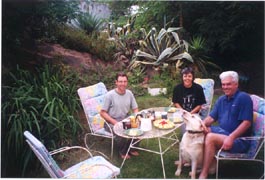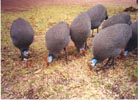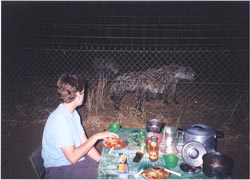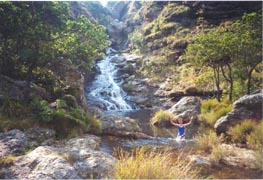SOUTHERN AFRICA
Zimbabwe & Kruger Park
South Africa
FROM NAMIBIA TO SOUTH
AFRICA , ZIMBABWE AND MOZAMIQUE
* From Windhoek, Namibia we
hopped on a 1850 kilometre bus ride to Johannesburg; the highlights included a
border crossing at 1:30 a.m. and a 5:00 a.m. bus transfer. Arriving in
Johannesburg, a strange thing happened; it rained (our first rain since
June).
* We house-sat for a week in
Joburg and did "normal" things like watch videos (Bonzo, the dog was only
interested in the animal parts) and sleep in a bed.
* From Joburg, we set out for
Kruger National Park in oulr rented "mini-magnum", a brand-new Mazda 323.
Whereas in Etosha National Park in Namibia, the animals practically walk over
each other at the waterholes in the dry season, in Kruger you have to look for
the game, but there is an impressive variety of animals, plenty of big cats and
good photographic opportunities. It took us 13 days to work our way from south
to north (Crocodile Bridge to Pufari) in Kruger. We braved the 6:00 a.m. rush
hour queue awaiting the camp gate opening at the larger camps. Lion kills along
main roads attracted huge quantities of vehicles, but the park has a mixture of
tar roads and quieter dirt roads (2,000 km in all). We had a baboon ride on top
of our car, we had 4 monkeys in our tent and 2 dwarf mongoose inside a dirty 1
litre pot. Up at Shingwedzi, the mid-day temperatures soared so we stayed there
3 nights and drank gin and tonics by the pool during the middle of the day;
there is nothing like going on safari in your bathing suit!
KRUGER TRAVEL
NOTES
Surprisingly afordable: a 5 USD
one-time entry fee and a nightly camping fee of about 5 USD/person. Our car cost
us 16 USD/day, so with fuel, food and booze it cost us about 20 USD/person/day.
Best Campsite: Balule has no
electricity (lighting by hurricane lamps). It has great hot showers and we had 7
hyaenas next to our tent (on the other side of the fence) and a herd of elephant
pass within meters of our tent another night. The campsite was developed for the
Asians during the apartheid years. The 5:15 a.m. wake-up call is a chorus of
lion roars, hyaena hooping, hippo laughing and francolin
squawking.
Keep Kruger Clean: Staff
regularly clean-up elephant dung off the paved roads (elephant drop 120 kg of
"fertilizer" each day).
Which animal would you rather
be?
- Giraffe sleep 20 minutes a
day
- Lion sleep 20 hours a
day
- Elephants eat 16-18 hours a
day
Kruger Banana Index: 8-10 bananas
for 1 USD
Kruger Gin Index: a bottle of
Gordon's Gin goes for 5 USD in the camp shops
Best Coiffeur: Crested Guinea
Fowl with warthogs and their Italian haircuts
runner-up.
Most oxpeckers seen on a Giraffe:
17
We saw in Kruger
Park:
Lions:
51
Leopards:
5
Cheetah:
6
Wild Dogs:
none
Rhino:
4
Different mammal species:
41
Different bird species:
140
Mosquitoes:
2
Speed traps: 2 (maximum is 50
kph)
Biggest snake: African Python (4
metres long)
Most poisonous snake: Black
Mamba
* We then crossed over the
chaotic Beitbridge border in Zimbabwe. Bicycles, plastic washbasins and huge
bags of "cheesies" seemed to be the thing to bring into Zimbabwe and a full tank
of gas and woodcarvings were the things to bring back into South Africa. We saw
over a thousand up-side down trees (Baobab) on our journey to the Chimanimani
Mountains.
* With assurance from a local
guide that land mines are no longer an issue, we set off on foot with our
hand-drawn map through the rugged Chimanimani National Park over Skeleton Pass
(an ancient slave traders route) into Mozambique (illegally, of course). We
eventually found Martin's Falls (about 150 metres high) and plenty of caves used
by poachers (snaring Klipspringers), while romping around the surprisingly wild
area.
* On returning to the Zimbabwe
side of the Chimanimani, we slept in 'Digbys' Cave" overlooking Digbys' Falls
only to discover it was infested with fleas (bed bugs or something that leaves
blood on your sheets) which happily munched our bodies for a number of days,
despite our best interest to rid ourselves of them. We are still scratching.
Sheila's interest in bugs seems to exclude the types that bite
her.
* We then visited the Great
Zimbabwe ruins which were shrouded in mist, adding to their mystery and
surprising size. Zimbabwe has lovely people, a good road system but a sad,
deteriorating economy.
* We decided to return to Joburg
vie Kruger, this time scratching our way fromnorth to south in 4 days. On our
last afternoon, we were caught sleeping at the switch. Waiting out a 15 minute
shower, we pulled over on a dirt road and began to read. When we looked up there
was a massive rhino crossing the road about 15 metres in front of us,
disappearing back into the tall grass. We figured we had missed out on him doing
a jig for us.
* So ends our luxury Southern
Africa tour. Fat and happy, we now leave our motor vehicles, cooler, brai grill,
chairs, pillows, propane stove, coffee maker and 5 litre box wines behind. We
get back on the saddle…off to Madagascar for 2 months! There is one internet
café in all of Madagascar, so we'll be off-line for a good
while…..
FOR THE
RECORD
Year to date tent nights:
127
Year to date cave nights:
2
And during our Southern African
Winter
Kilometers by motor vehicle:
21,800
Kilometers by bicycle:
40
Hottest temperature: 38 degrees
C
Coldest temperature: minus 7
degrees C
Longest period without rain: 58
consecutive days (all but one were sunny)
More new mammals spotted: white
tailed mongoose, dwarf mongoose, white rhino, reedbuck, nyala, sharpes"s
grysbok, sidebanded jackal, springhare and lichtenstein's
hartebeest.





